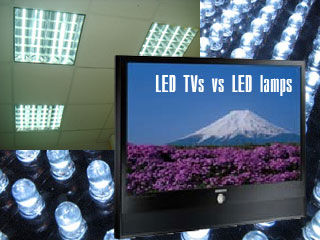LED TVs vs LED lamps
LED technologies have established a firm foothold in the world market of lighting. Most developed countries have introduced programs of phasing out conventional lighting using incandescent lamps ineffective in terms of power consumption. Fluorescent lamps will soon follow the suit and lose the marketplace to LED lamps.

Until recently the market of energy-efficient lamps demonstrated a healthy annual growth at the level of 30%. However, when the financial crisis settled in the situation started to change. Experts believe that in 2009 the energy-saving lamp market lost momentum and grew 10-15% at most (59.5-63 million units) while in 2008 the production was reported at the level of 70 million lamps.
Low efficiency of incandescent lamps and growing energy tariffs forced governments to seriously consider power-saving technologies. Fast advances in nanotechnologies made the replacement of incandescent and fluorescent lamps a near-future reality. The target markets of all these products are basically the same: lighting of large industrial, administrative and office complexes. It is there that energy-saving becomes the prime objective.
Governments started supporting these energy-saving initiatives for another reason as well: LED lighting is ecologically friendly, does not contain mercury and other hazardous substances. LED (Light-emitting diode) is a semiconductor that transfers electrical current into luminous flow directly. The resulting light is excellent in quality and is economical in terms of power consumption. For example, in the year 2000 a 100 sq. meter lamp video screen had the rated power consumption of 600 kW, a similar LED video screen but with significantly better resolution today use not more than 30 kW).
LEDs do not contain any hazardous admixtures (fully correspond to RoHS standard), do not emit UF, do not require specialized utilization programs (compared to fluorescent lamps, for example). Add to this much longer service life of LED lamps which is generally five times longer than that of incandescent and fluorescent lamps and the reason for choosing LED technology becomes evident.
In the stable year of 2008, the overall sales of LED lighting reached 54% compared to traditional lighting systems worldwide. LED manufacturing became one of the most attractive industries from the point of view of new investments.
Market reviews indicated that 30% of 2009 overall worldwide sales continued to be traditional incandescent lamps, 28% - fluorescent lamps, and the rest were the energy-saving gas lamps and LED lamps. This shows the significant shift in market preferences, something to remember to follow up in future. Sales of energy-saving lamps went up from 25.7% to 28% and of LED lamps from3.8% to 4.5%.
According to market analysts, in future the sales of energy-saving and LED lamps will continue to grow, but LED lamps will gradually catch up and then overtake energy-saving lamps in popularity. Today Europe remains the largest market for new technologies in the area of lighting with the total sales volume of nearly 23.5 billion USD in 2009. According to Freedonia Group, other most dynamic markets for new types of lighting are:
- China – growth rate of 8.9%;
- Eastern Europe – 7.8%;
- Africa – 6.1%;
- Latin America – 5.8%;
- Canada and Mexico – 5%.
Russia so far remains a staunch supporter of incandescent lamps. LED lamps in Russia are less common than iPads. Nevertheless, most experts believe that Russia will be an important market for LED lighting in the near future. Currently, the most developed LED market segment in Russia is an architectural lighting, design projects and outdoor advertising applications. However, the public is gradually becoming aware of better and more economical home and office lighting options.
At a time when LED lighting seemed to be an established market trend and the strategic way of implementing energy-saving technologies, it stumbled against an unexpected obstacle. A new application was found for LEDs – backlighting for modern LCD TV (so called LED TV). Since the profit margin in TV sales is significantly higher compared to LED lighting, LED manufacturers immediately reoriented production lines to new product requirements. As a result, many LED lamp manufacturers are currently surviving on limited LED supplies. We are sure that the situation will improve in 6-10 months, but the current LED shortage for LED lamps will definitely affect LED lamp supplies worldwide.
For manufacturers and traders the most effective factor is the recent Federal Law “On energy saving and increased energy efficiency in the Russian Federation” that paves the way for a mandatory replacement of all incandescent lamps of 100W and more by the year 2011. The overall energy saving for the country will reach approximately 10-20%. The state reform will start with federal buildings, for the general public the ban for incandescent lamps will start with 100W incandescent lamps on 1 Jan 2011, 75W – from 1 Jan 2013, 25W – from 1 Jan 2014.
Thus, by 1 Jan 2014 the incandescent lamps will be permanently banned in the Russian Federation. The market will then be free for LED lamps.





